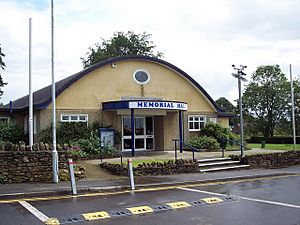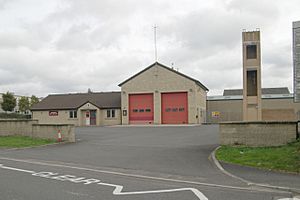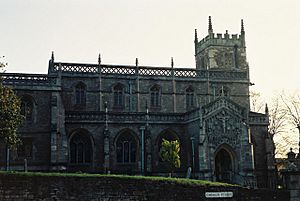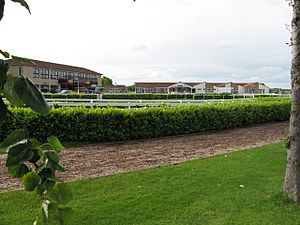Wincanton facts for kids
Quick facts for kids Wincanton |
|
|---|---|
 Wincanton High Street |
|
| Population | 6,568 (2021) |
| OS grid reference | ST712286 |
| District | |
| Shire county | |
| Region | |
| Country | England |
| Sovereign state | United Kingdom |
| Post town | WINCANTON |
| Postcode district | BA9 |
| Dialling code | 01963 |
| Police | Avon and Somerset |
| Fire | Devon and Somerset |
| Ambulance | South Western |
| EU Parliament | South West England |
| UK Parliament |
|
Wincanton is a town and an area for voting in South Somerset, southwest England. The town is located near the A303 road, which is a main route between London and South West England. Wincanton also has some light industries. In the 2021 census, the town had a population of 6,568 people.
Contents
- What Does the Name Wincanton Mean?
- A Look at Wincanton's Past
- How Wincanton is Governed
- Community Services in Wincanton
- Wincanton's Location and Weather
- Wincanton's Economy
- Important Buildings in Wincanton
- Getting Around Wincanton
- Media in Wincanton
- Education in Wincanton
- Religious Buildings
- Culture and Museums
- Famous People from Wincanton
- Sports in Wincanton
- Wincanton's Twin Towns and Discworld Connection
- See also
What Does the Name Wincanton Mean?
The name Wincanton was first written down in 1084. It appeared as Wincainietone and Wincautone. In the Domesday Book of 1086, it was spelled Wincaleton.
The town's name comes from the River Cale, which flows through Wincanton. In Old English, the river was called Wincawel. This was combined with the Old English word tūn, which means "estate" or "settlement". So, Wincanton once meant "estate on the River Cale".
The name of the River Cale itself is a bit of a mystery. It might come from a very old word meaning "basket". This could refer to fish-traps used in the river. The "win-" part of the name might mean "white". Sometimes, different parts of the same river were called "white" or "black" to tell them apart.
A Look at Wincanton's Past
Early History and Battles
On Windmill Hill, archaeologists found a Bronze Age burial site. This shows people lived here a very long time ago. Before the Norman Conquest in 1066, Wincanton was often a place where battles happened. Britons, Danes, and Saxons fought here. During the time of Edmund Ironside, the English army defeated the Danes, making them leave England.
Norman Castles and Markets
Cockroad Wood Castle was a type of castle called a motte and bailey. It was likely built after the Normans took over England in 1066. This castle was near other Norman castles, suggesting it was part of a plan to control the area.
Wincanton probably had a market in the Middle Ages. However, it didn't officially get a market and fair charter until 1556.
The Glorious Revolution and Fires
Wincanton was the site of a small fight during the Glorious Revolution in 1688. On November 20, 1688, soldiers loyal to King James II fought against troops supporting William of Orange. King James's soldiers won this skirmish.
Sadly, large parts of the town were destroyed by big fires in 1707 and 1747.
Later History
In the early 1800s, during the Napoleonic Wars, Wincanton was a place where French officers were held. By 2010, many people from other countries, especially Portugal and Poland, had moved to Wincanton.
How Wincanton is Governed
Wincanton is part of the Somerset County Council area. It is also in the Non-metropolitan district of South Somerset. The town has its own town council.
What the Town Council Does
The town council handles local issues. They set a local tax to cover their costs. They also check plans for new buildings. The council works with the police and local groups to deal with crime, safety, and traffic. They also start projects to fix and maintain town facilities. They talk with the district council about roads, drainage, footpaths, public transport, and street cleaning. The council also looks after conservation and environmental matters.
Other Councils' Roles
The South Somerset district council is in charge of local planning and building rules. They also manage local roads, council housing, and environmental health. They handle markets, rubbish collection, recycling, cemeteries, parks, and tourism.
The Somerset County Council manages bigger and more expensive services. These include education, social services, libraries, main roads, public transport, and waste disposal.
National Representation
Wincanton is part of the Glastonbury and Somerton area. This area elects a member of parliament to the House of Commons. The current member of parliament is Sarah Dyke from the Liberal Democrats party.
Community Services in Wincanton
Wincanton Community Hospital, located on Dancing Lane, used to be called Verrington Hospital. In March 2015, it had 28 beds and an intermediate care unit. It first opened in September 1910 as an Isolation Hospital for patients with scarlet fever.
The Balsam Centre is a place for healthy living. It is also a Children's Centre for Wincanton and the surrounding area.
The War Memorial Hall opened on January 9, 1959. It has a stage and can seat 250 people for dancing or events. There is also a smaller room for meetings.
Fire, police, and ambulance services are shared with other areas. These are provided by the Devon and Somerset Fire and Rescue Service, Avon and Somerset Constabulary, and the South Western Ambulance Service.
Wincanton's Location and Weather
Where is Wincanton?
Wincanton is on the northeast edge of Blackmore Vale. It is about 12 kilometers (7.5 miles) northeast of Yeovil. It is also about 10 kilometers (6.2 miles) northwest of Shaftesbury. The town is in the far southeast of Somerset, close to the borders of Dorset and Wiltshire.
Wincanton's Climate
Like the rest of South West England, Wincanton has a mild climate. It is usually wetter and milder than other parts of the UK. The average yearly temperature is about 10°C (50°F). January is the coldest month, with temperatures between 1°C (34°F) and 2°C (36°F). July and August are the warmest months, with daily highs around 21°C (70°F).
Clouds often form inland, especially near hills. This means there are fewer hours of sunshine. The area gets about 1,600 hours of sunshine each year.
Rain usually comes from storms moving in from the Atlantic Ocean. These storms are stronger in autumn and winter. The average rainfall is about 725 millimeters (28.5 inches) per year. Winds are strongest from November to March and lightest from June to August. The wind usually blows from the southwest.
Wincanton's Economy
Dairy Industry and Logistics
In the late 1890s, the West Surrey Central Dairy Company bought a local creamery in Wincanton. In 1908, after making a dried milk baby powder, the company changed its name to Cow & Gate. This creamery had its own train tracks. This allowed milk trains to easily transport milk products.
To help with transport, Cow & Gate started a special shipping part of their business in 1920. This part of the company later became Wincanton plc in 2002. Wincanton plc is now a very large logistics company. They still have a dairy products base in the town.
In 1999, Unigate sold its remaining dairies to Dairy Crest. Dairy Crest still has a creamery and milk processing plant in Wincanton. However, they sold the cheese business to Adams Foods Ltd, which makes Pilgrim's Choice Cheddar cheese.
Other Local Businesses
Several other businesses are located in Wincanton. Coffee Sense Coffee Roasters won an award in 2017. Boxclever Press Ltd received a special award from the Queen in 2019 for its success in international trade.
Important Buildings in Wincanton
The Dogs (also called The Old House) was built around 1650. It was later changed inside by Nathaniel Ireson in the 1740s. It is a very important historic building.
Wincanton Town Hall was finished in 1878. It is the third town hall built on that spot.
Getting Around Wincanton
Past and Present Transport
Wincanton used to have a train station on the Somerset and Dorset Joint Railway. But this station closed on March 7, 1966.
The town is just north of the A303 road. This is one of the main roads connecting London and South West England.
The closest train stations today are in nearby Templecombe railway station and Castle Cary railway station.
Berrys Coaches offers a "Superfast" bus service to and from London twice a day.
Media in Wincanton
Local news and TV shows come from BBC West and ITV West Country. TV signals are received from the Mendip TV transmitter.
Local radio stations include BBC Radio Somerset (95.5 FM), Heart West (102.6 FM), Greatest Hits Radio South West (106.6 FM), Abbey104 (104.7 FM), and Radio Ninesprings (104.5 FM).
The local newspaper for the town is the Western Gazette, which comes out every Thursday.
Education in Wincanton
Primary Schools
Children up to age 11 can attend Wincanton Primary School or Our Lady of Mount Carmel Catholic Primary School.
Wincanton Primary School started in 1833. After some challenges, the school was built in North Street in 1838. In 1871, a school board was formed and opened a school in the old building with over 200 students. By 1875, there were 206 children attending. In 1894, money was raised for a new school for 445 children. This new school opened in South Street in 1897.
Secondary School
Wincanton has one secondary school, King Arthur's School. It was Somerset's first specialist Sports College.
Community Learning
The Balsam Centre is a Healthy Living Centre and a Children's Centre. Since 2005, it has received money to improve its training kitchen and create teaching areas, counseling rooms, and a studio for activities.
Religious Buildings
The Church of St Peter and St Paul was mostly rebuilt between 1887 and 1891. However, parts of its tower might be from an older church built in 1313. In 1793, the tower was made 3.6 meters (12 feet) taller, reaching 15 meters (50 feet) high. Five bells were added, and then a sixth. The churchyard has a monument to local architect Nathaniel Ireson. The church's roofs need repair, so it is on the Heritage at Risk Register.
The Roman Catholic Church of St Luke and St Teresa was built in 1881.
There are also places of worship for Pentecostals, Methodists, Baptists, and Quakers in Wincanton.
Culture and Museums
Wincanton Museum is a small local museum that used to be on the High Street. It closed in 2010. You can now see some of its items in the library on Carrington Way.
In 2023, the museum reopened in a new spot on the high street. It offers free entry to see its artifacts.
Famous People from Wincanton
The cartoonist Tony Weare was born in Wincanton.
Sports in Wincanton
The town gives its name to Wincanton Racecourse, which is in the nearby area of Charlton Musgrove.
Wincanton has a Non-League football club called Wincanton Town F.C.. They play at the Wincanton Sports Ground on Moor Lane. This Sports Ground also has places for tennis and bowls.
Wincanton Sports Centre opened in 2001. It was built with money from a National Lottery grant.
The cricket club plays at the recreation ground. It has two Saturday teams and one Sunday team.
The rugby union club plays at King Arthur's Community School in the town. In 2010, they won their division in the English Rugby Union South West Division.
Wincanton's Twin Towns and Discworld Connection
Wincanton has a special connection: it is twinned with a town that only exists in books! Besides being twinned with Gennes / Les Rosiers in France and Lahnau in Germany, Wincanton is also twinned with Ankh-Morpork. Ankh-Morpork is a made-up city from Terry Pratchett's Discworld books.
In 2009, some new roads in Wincanton were given names from Ankh-Morpork. Examples include Peach Pie Street and Treacle Mine Road. Fans of Discworld voted on these names. There are even shops in Wincanton that sell items related to Discworld. In 2015, a pub called Uncle Tom's Cabin put up a new sign. It was designed by Discworld artist Richard Kingston and showed a scene from The Mended Drum, another Discworld location. Terry Pratchett and Richard Kingston often visited this pub.
Another Discworld connection is in Cale Park. A new bridge was built over the River Cale, connecting the main park to the children's play area. The public chose the name 'Troll Bridge' for it. This name comes from a short story by Terry Pratchett and a short film based on it.
See also
 In Spanish: Wincanton para niños
In Spanish: Wincanton para niños







